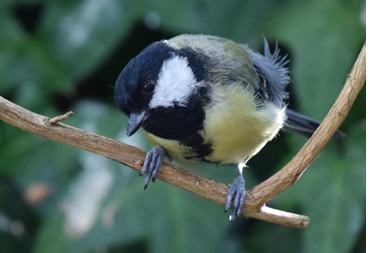David M. Larson

Great Tit. Photograph by Heather Smithers (CC-BY-SA 2.0).
We all know about anthropogenic changes in avian distribution and diversity—think loss of habitat, introduced species, and extinction, for example. Increased food supplies due to birdfeeders and introduction of non-native plants may have helped fuel range expansion in some species. Anthropogenic climate change threatens many species that are unable to adapt quickly enough. But there are more subtle changes out there, too.
Bosse, et al., 2017, studied morphological and genetic changes in Great Tits (Parus major) that ultimately proved to result from human intervention in the form of birdfeeding. In the United Kingdom (UK), birdfeeders are widely employed in gardens, as opposed to in the Netherlands where they are much less common. The authors used fine scale ecological and genomic data to analyze adaptive evolution at separate locations in this well characterized, widely distributed, and abundant Old World passerine.
From a genomic point of view, Great Tits have a large effective population size and high levels of gene flow. The authors started off with genetic analysis of over 2000 Great Tits, focusing on nearly a half million single nucleotide DNA changes—single nucleotide polymorphisms or SNPs. Computer analysis of the SNPs identified some that appeared to be under different selection pressures in the populations from England and the Netherlands. The majority of the genomic regions identified contained genes associated with skeletal development, bone growth, and palate development. The strongest SNPs were at genes that had been previously associated with beak shape in studies on Darwin's finches (subfamily Geospizinae). Over 3000 of the total SNPs were associated with bill length variability, suggesting that bill length control depends on expression of many genes. These genomic analyses suggested that bill morphology might be differentially controlled in the English and Netherlands Great Tit populations and, indeed, UK Great Tits have longer bills than the continental birds.
The authors carried out further analyses on the COL4A5 gene, a Type IV collagen gene, which was in a chromosomal segment most notably associated with variations in bill length. The analyses showed clear recent selection for longer bills in the UK population, with the COL4A5-C allele being much more abundant in the UK than in continental birds.
The mechanism of COL4A5-C selection leading to increased bill length was assessed by analyses of the reproductive success of birds containing this allele. The data showed that birds with one or two copies of the COL4A5-C allele were statistically more likely to successfully fledge young in the UK than were birds without that allele. Though not statistically significant, the opposite tendency was detected in the Netherlands birds. The authors suggest that adults possessing this allele have a fitness advantage in the UK population.
While there is no known difference in natural diet in UK versus mainland Europe Great Tits, there is a considerable difference in the availability of human-supplied birdseed. Birdfeeding in the UK has been widespread since the 19th century, and UK citizens spend twice as much on birdseed as the whole of mainland Europe. Great Tits are famously good at exploiting feeders, so the final piece of this puzzle is if feeder utilization could select for longer bills in Great Tits, as has been suggested for Eurasian Blackcaps (Sylvia atricapilla) by Rolshausen et al., 2009. Studies using RFID-enabled feeders in the British site over three winters showed that tits with two copies of the COL4A5-C allele were more likely to visit feeders than birds with one copy or none, and a follow-up study pairing feeding frequency with bill length showed a positive correlation.
Ultimately, this study provides a neat story of natural selection in a wild population of birds, starting from finding genetic differences in two remote populations, demonstrating a linkage between those genetic differences and genes important in bill morphology, breeding fitness as a measure of selection, and phenotypic variation and evolutionary change as a driver of selection. Clearly some of the connections in the chain of events can use further scrutiny, but the overall conclusion that Great Tits using birdfeeders in the UK show selection for longer bill length seems logical. Given the multi-gene basis of any morphological change, more studies are clearly needed to fill in the details.
References
- Bosse, M., L.G. Spurgin, V.N. Laine, E.F. Cole, J.A. Firth, P. Glenapp, A. G. Gosler, K. McMahon, J.Poisssant, I. Verhagen, M.A.M. Groenen, K. van Oers, B.C. Sheldon, M.E. Visser, and J. Slate. 2017. Recent natural selection causes adaptive evolution of an avian polygenic trait. Science 358: 365–68.
- Rolshausen, G., G. Segelbacher, K.A. Hobson, and H.M. Schaefer. 2009. Contemporary evolution of reproductive isolation and phenotypic divergence in sympatry along a migratory divide. Current Biology 19: 2097–101.
David M. Larson, PhD, is the Science and Education Coordinator at Mass Audubon's Joppa Flats Education Center in Newburyport, the Director of Mass Audubon's Birder's Certificate Program and the Certificate Program in Bird Ecology (a course for naturalist guides in Belize), a domestic and international tour leader, President of the Nuttall Ornithological Club, and a member of the editorial staff of Bird Observer.